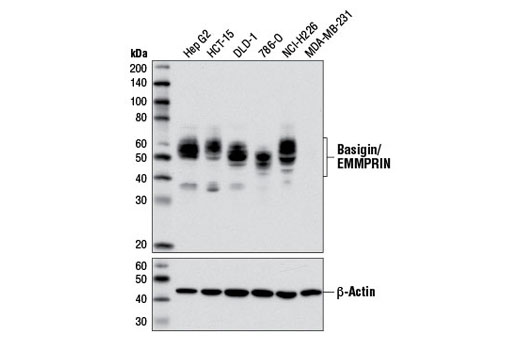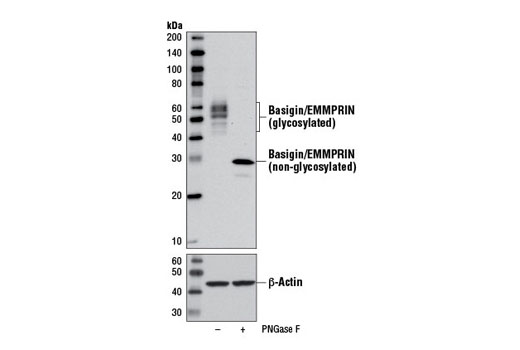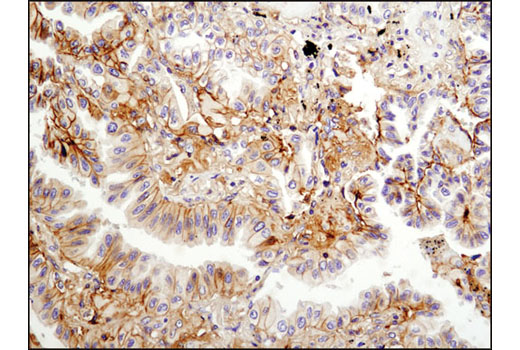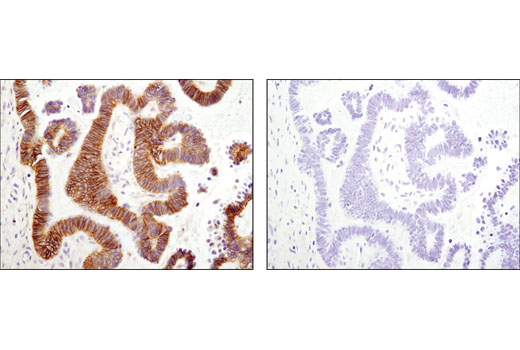WB, IHC-P
H
Endogenous
38-58
Rabbit IgG
#P35613
682
Product Information
Product Usage Information
| Application | Dilution |
|---|---|
| Western Blotting | 1:1000 |
| Immunohistochemistry (Paraffin) | 1:200 - 1:800 |
Storage
Specificity / Sensitivity
Species Reactivity:
Human
Source / Purification
Monoclonal antibody is produced by immunizing animals with a synthetic peptide corresponding to residues surrounding Ala254 of human EMMPRIN protein.
Background
Basigin (EMMPRIN, CD147) is a type I integral membrane receptor protein belonging to the immunoglobulin superfamily (1). Basigin is a glycosylated protein with four known isoforms, of which isoform 2 is the most abundantly expressed (2). Multiple functions have been ascribed to Basigin; foremost among these is stimulating the secretion of extracellular matrix metalloproteinases by adjacent fibroblasts, a function which has been implicated in promoting tumor progression (2-4). Research studies have shown that Basigin is overexpressed by many tumor cells, and its expression level may correlate with tumor malignancy (5,6). A recent study identified the BASIGIN gene as a regulatory target of Slug, suggesting a role for Basigin in the process of epithelial-mesenchymal transition (7). Basigin has also been identified as a marker for a subset of highly suppressive regulatory T cells (8), and as an obligate receptor for the malarial parasite Plasmodium falciparum on human erythrocytes (9).
- Biswas, C. et al. (1995) Cancer Res 55, 434-9.
- Liao, C.G. et al. (2011) Mol Cell Biol 31, 2591-604.
- Sweeny, L. et al. (2012) Exp Cell Res 318, 1788-98.
- Lescaille, G. et al. (2012) BMC Cancer 12, 115.
- Piao, S. et al. (2012) J Cancer Res Clin Oncol 138, 627-35.
- Bi, X.C. et al. (2011) Clin Invest Med 34, E358.
- Wu, J. et al. (2011) Oncogene 30, 4410-27.
- Solstad, T. et al. (2011) Blood 118, 5141-51.
- Crosnier, C. et al. (2011) Nature 480, 534-7.
Species Reactivity
Species reactivity is determined by testing in at least one approved application (e.g., western blot).
Western Blot Buffer
IMPORTANT: For western blots, incubate membrane with diluted primary antibody in 5% w/v nonfat dry milk, 1X TBS, 0.1% Tween® 20 at 4°C with gentle shaking, overnight.
Applications Key
WB: Western Blotting IHC-P: Immunohistochemistry (Paraffin)
Cross-Reactivity Key
H: human M: mouse R: rat Hm: hamster Mk: monkey Vir: virus Mi: mink C: chicken Dm: D. melanogaster X: Xenopus Z: zebrafish B: bovine Dg: dog Pg: pig Sc: S. cerevisiae Ce: C. elegans Hr: horse GP: Guinea Pig Rab: rabbit All: all species expected
Trademarks and Patents
Limited Uses
Except as otherwise expressly agreed in a writing signed by a legally authorized representative of CST, the following terms apply to Products provided by CST, its affiliates or its distributors. Any Customer's terms and conditions that are in addition to, or different from, those contained herein, unless separately accepted in writing by a legally authorized representative of CST, are rejected and are of no force or effect.
Products are labeled with For Research Use Only or a similar labeling statement and have not been approved, cleared, or licensed by the FDA or other regulatory foreign or domestic entity, for any purpose. Customer shall not use any Product for any diagnostic or therapeutic purpose, or otherwise in any manner that conflicts with its labeling statement. Products sold or licensed by CST are provided for Customer as the end-user and solely for research and development uses. Any use of Product for diagnostic, prophylactic or therapeutic purposes, or any purchase of Product for resale (alone or as a component) or other commercial purpose, requires a separate license from CST. Customer shall (a) not sell, license, loan, donate or otherwise transfer or make available any Product to any third party, whether alone or in combination with other materials, or use the Products to manufacture any commercial products, (b) not copy, modify, reverse engineer, decompile, disassemble or otherwise attempt to discover the underlying structure or technology of the Products, or use the Products for the purpose of developing any products or services that would compete with CST products or services, (c) not alter or remove from the Products any trademarks, trade names, logos, patent or copyright notices or markings, (d) use the Products solely in accordance with CST Product Terms of Sale and any applicable documentation, and (e) comply with any license, terms of service or similar agreement with respect to any third party products or services used by Customer in connection with the Products.



